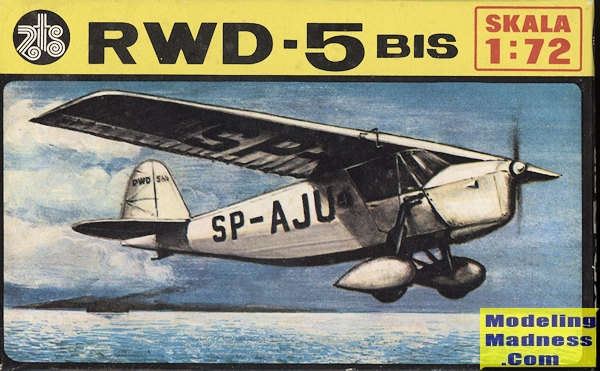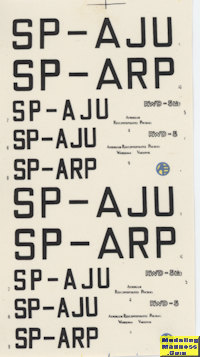
| KIT #: | S-05 |
| PRICE: | $3.00 or so when new |
| DECALS: | Two registration numbers |
| REVIEWER: | Scott Van Aken |
| NOTES: |

| HISTORY |
The RWD 5 was constructed by the RWD team of Stanisław Rogalski, Stanisław Wigura and Jerzy Drzewiecki (their designs were named RWD after their initial letters). It was a further development of earlier RWD aircraft series (RWD 1, RWD 2, RWD 3 and RWD 7), especially of its direct predecessor, the RWD 4. It shared the same wing shape and construction, while the fuselage was totally new, constructed of steel frame, unlike its wooden predecessors. The fuselage had a modern shape and a closed canopy with panoramic windows (earlier models had atypical fish-shaped fuselages with no direct forward view from the pilot's seat).
The first prototype (registration SP-AGJ) was flown on 7 August 1931 by its designer Jerzy Drzewiecki. It was built in new workshops of Warsaw University of Technology near Okęcie airport, from 1933 converted to Doświadczalne Warsztaty Lotnicze (DWL) company.
After successes of the prototype in air competitions, a small-scale series production was set up, mostly for the Polish Aero Club. Series aircraft had improved landing gear. Two were built in 1932 (registration SP-AJA and AJB), five in 1933 (including the single-seater RWD 5bis), eleven in 1934 (including one in Aero Club workshops in Lublin) and one more in 1937 (SP-BGX), for a total of 20 aircraft. In 1932, the RWD 5 was shown at the International Air Show in Paris. The RWD-5bis gained fame for flying the South Atlantic from Senegal to Brazil non-stop and setting a distance record for small light aircraft.
| THE KIT |
 This
is a kit I've had in the collection for so long that I don't recall where I
got it. The kit is definitely from the Cold War era as the box and
instructions are in a pretty cheap paper/cardboard, the decals have so much
carrier that they are basically on a solid sheet and the plastic is in a
rather bright turquoise color. The two colored and one clear sprue are
pretty nicely molded with the fabric parts of the airframe having a rather
rough texture. While the clear bits are not all that transparent, for
something like this, they are good enough. The only real flash is on the
long exhaust and there are some ejector and sink marks, but nothing really
horrible.
This
is a kit I've had in the collection for so long that I don't recall where I
got it. The kit is definitely from the Cold War era as the box and
instructions are in a pretty cheap paper/cardboard, the decals have so much
carrier that they are basically on a solid sheet and the plastic is in a
rather bright turquoise color. The two colored and one clear sprue are
pretty nicely molded with the fabric parts of the airframe having a rather
rough texture. While the clear bits are not all that transparent, for
something like this, they are good enough. The only real flash is on the
long exhaust and there are some ejector and sink marks, but nothing really
horrible.  obably
the most complex part of the kit. This consists of the main inner struts
which are a single mold along with the lower fuselage in that area. Two
outer struts then attach to the wheel pants. These items are in left and
right halves with the wheels molded in place. Not all these planes had the
pants so you'll have to dig through your spares box for wheels. A tail skid
is on the rear with the three transparency pieces fitting in after most of
themodel is built and before the wing is installed.
obably
the most complex part of the kit. This consists of the main inner struts
which are a single mold along with the lower fuselage in that area. Two
outer struts then attach to the wheel pants. These items are in left and
right halves with the wheels molded in place. Not all these planes had the
pants so you'll have to dig through your spares box for wheels. A tail skid
is on the rear with the three transparency pieces fitting in after most of
themodel is built and before the wing is installed. | CONCLUSIONS |
Though this may be an old kit, it is nicely molded and I have to admit that injected plastic kits of Polish interwar light planes are few and far between.
| REFERENCES |
https://en.wikipedia.org/wiki/RWD_5
June 2016
Copyright ModelingMadness.com
Thanks to me for picking this one up.
If you would like your product reviewed fairly and quickly, please contact the editor or see other details in the Note to Contributors.